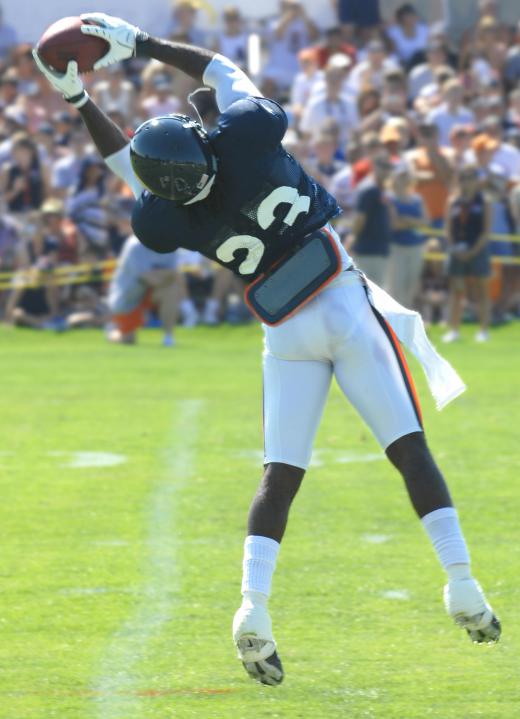There are three main ways for a team to score points in American football: by carrying the ball across the opponent's goal line, by possessing the ball or tackling an opposing ballcarrier in the opponent's end zone or by kicking the ball through the opponent's goalposts. It also is possible for a team to score points under certain circumstances when the opponent commits a penalty in its own end zone or fumbles the ball out of bounds in its own end zone. Each way of scoring has a name and is worth a specific number of points. A touchdown is worth six points, a field goal is worth three points, a safety usually is worth two points, and a try is worth either one or two points.
Touchdowns

A touchdown is scored when a player has possession of the football and it crosses the opposing team's goal line or when a player gains possession of the ball in the opponent's end zone. When the ball is possessed in the field of play, any part of the ball touching an imaginary plane over the goal line results in a touchdown. For example, a player who is being tackled near the goal line can reach out with the ball and score a touchdown if it crosses the goal line before the player is down. When a player who is already in the end zone gains possession of the ball, such as catching a pass or recovering a fumble, it is a touchdown as long as the player was legally in bounds when he gained possession of the ball.
Tries

After a touchdown, the scoring team is given one play to score again from near the goal line. This is called a try and is worth one or two points, depending on how the team scores. At most levels of football, kicking the ball through the goalposts on a try— called an extra-point kick or point-after-touchdown (PAT) — is worth one point, and running or passing the ball into the end zone is worth two points and usually is called a two-point conversion.

In some leagues, such as those for youth players, the points awarded for tries are switched, because kicking the ball through the goalposts is considered to be a more difficult task for young players. Other leagues might award one point for a run and two for a pass. At many levels, it also is possible for the defensive team to score a two-point conversion by gaining possession of the ball on a try attempt and carrying the ball into the opponent's end zone.
Field Goals

If the team that has the ball — the offense — does not score a touchdown, it might be able to kick a field goal. This is the same as an extra-point kick but usually is from a greater distance. A team usually will attempt a field goals only after exhausting its chances to score a touchdown while still in possession of the ball. One exception is when the team is trailing by three points or less near the end of the game. For example, in the final minute of a game that is tied, the offensive team might not try to score a touchdown if it already is close enough to attempt a relatively easy field goal.
Safeties

A safety is the least common scoring play in football, and it usually is scored by the team that does not have possession of the ball — the defense. It occurs when an offensive player who has the ball is tackled or goes out of bounds in the offense's own end zone, when a ball that was fumbled or batted by a team goes out of bounds in its own end zone or when the offensive team commits a penalty in its own end zone. It is not a safety, however, if a player gains possession of the football in his team's own end zone and is tackled or goes out of bounds before advancing out of the end zone.
One-Point Safeties

Another, little-known way of scoring can occur only on a try attempt and is known as a one-point safety. This happens when the play normally would result in a safety against the defense. For example, if the team that is attempting the try fumbles the ball and a defensive player bats the ball through the defense's end zone and out of bounds, the offensive team would be awarded a one-point safety. Another example would be a defensive player intercepting a pass on a two-point conversion attempt, then running into his own end zone and being tackled. One-point safeties are extremely rare, and some leagues do not even allow them.
Both football and putting require focus, precision, and coordination. Practicing on a putting green at home can enhance your ability to stay calm under pressure and develop a steady hand, skills that are valuable in football, especially for quarterbacks and kickers. Additionally, putting involves reading the greens and adjusting your aim, which translates well to kicking accuracy in football. By regularly practicing on your home putting green, you can build the mental and physical skills that will positively impact your performance on the football field.
